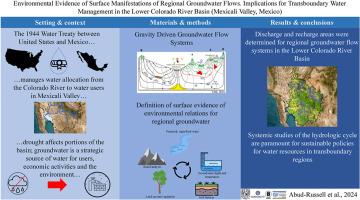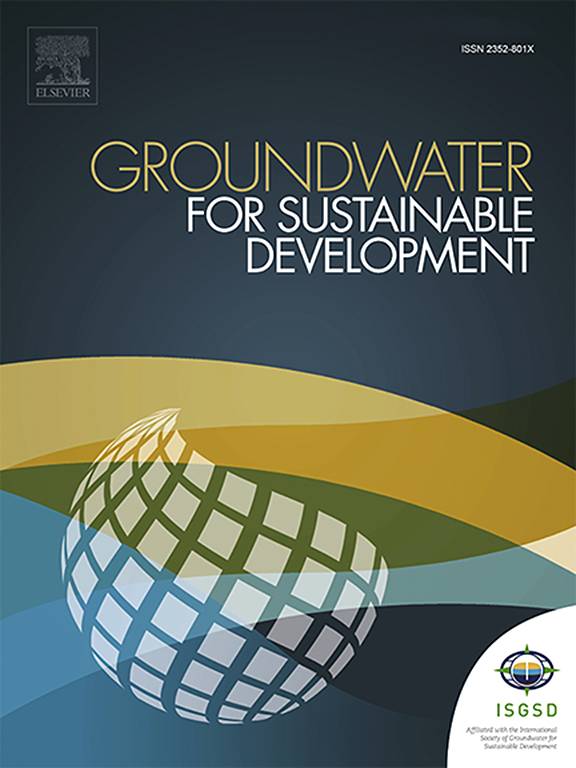科罗拉多河下游地区地下水流动地表表现的环境证据:以墨西哥墨西卡利河谷为例
IF 4.9
Q2 ENGINEERING, ENVIRONMENTAL
引用次数: 0
摘要
墨西哥和美国共享的科罗拉多河下游流域的跨界水资源需要强有力的合作治理框架来应对干旱和日益增长的用水需求。虽然地下水资源在满足这两个国家的用水需求方面日益具有战略意义,但它们很少在官方研究中得到正式考虑。本研究通过地理空间分析,描绘了科罗拉多河下游美国部分地下水和地表水系统相互连通的补给和排放带的空间分布,以表征地下水流动的区域成分。该研究采用基于Tóthian重力驱动地下水流动系统框架的方法,强调地下水与常年地表水、土壤分类、土地利用和土地形态的相互联系,作为其在整个流域地表表现的间接证据。结果在与区域地下水流动有关的排水和补给带中得到了体现。结果强调了两国数据统一和整合过程的必要性,以加强美国-墨西哥边境可持续管理的可用地下水评估工具。本文章由计算机程序翻译,如有差异,请以英文原文为准。

Environmental evidence of surface manifestations of regional groundwater flows in the lower Colorado River Basin: the case Mexicali Valley, Mexico
Transboundary water in the Lower Colorado River Basin, shared between Mexico and the United States, demands robust, collaborative governance frameworks to address drought and increasing water demands. Although groundwater resources have become increasingly strategic for meeting water demands in both countries, they rarely receive formal consideration in official studies. Through geospatial analysis, this research delineates for the US portion of the Lower Colorado River Basin, the spatial distribution of recharge and discharge zones within the interconnected groundwater and surface water systems to characterize the regional components of groundwater flow. Employing a methodology based on the Tóthian framework of gravity-driven groundwater flow systems, the study emphasizes the interconnection of groundwater with perennial surface water, soil taxonomy, land use and land-forms as indirect evidence of its surface manifestation throughout this basin. The results are represented in discharge and recharge zones related to regional groundwater flow. Results highlight the need for binational data homologation and integration process to strengthen the available groundwater assessment tools for sustainable management in the U.S.-Mexico border.
求助全文
通过发布文献求助,成功后即可免费获取论文全文。
去求助
来源期刊

Groundwater for Sustainable Development
Social Sciences-Geography, Planning and Development
CiteScore
11.50
自引率
10.20%
发文量
152
期刊介绍:
Groundwater for Sustainable Development is directed to different stakeholders and professionals, including government and non-governmental organizations, international funding agencies, universities, public water institutions, public health and other public/private sector professionals, and other relevant institutions. It is aimed at professionals, academics and students in the fields of disciplines such as: groundwater and its connection to surface hydrology and environment, soil sciences, engineering, ecology, microbiology, atmospheric sciences, analytical chemistry, hydro-engineering, water technology, environmental ethics, economics, public health, policy, as well as social sciences, legal disciplines, or any other area connected with water issues. The objectives of this journal are to facilitate: • The improvement of effective and sustainable management of water resources across the globe. • The improvement of human access to groundwater resources in adequate quantity and good quality. • The meeting of the increasing demand for drinking and irrigation water needed for food security to contribute to a social and economically sound human development. • The creation of a global inter- and multidisciplinary platform and forum to improve our understanding of groundwater resources and to advocate their effective and sustainable management and protection against contamination. • Interdisciplinary information exchange and to stimulate scientific research in the fields of groundwater related sciences and social and health sciences required to achieve the United Nations Millennium Development Goals for sustainable development.
 求助内容:
求助内容: 应助结果提醒方式:
应助结果提醒方式:


